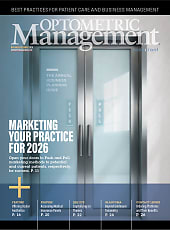ONE CHALLENGE to effectively managing myopia is that parents and some practitioners don’t become concerned about myopia progression until the magnitude of myopia reaches some threshold level. After all, when a 7-year-old child presents at –1.00 D, the patient can still function in many environments without corrective lenses, which makes it easy to brush off the case as a potential issue for a later date. So why not wait a few years and reassess the need for myopia intervention if the prescription exceeds, say, –3.00 D?
Why Age Matters
Put simply, age of onset is the strongest predictor of the severity of future myopia in adulthood (Chua et al, 2016; Hu et al, 2020). Emmetropic children between ages 6 and 8 experience about 3 times more physiologic (non-myopic) axial elongation than those between 12 and 14 (Zadnik et al, 2004). Thus, it should not be a surprise that younger myopes experience more rapid myopia progression, on average (Nixon and Brennan, 2020).
Approximately 50% of children diagnosed with myopia at 7 to 8 years old progress to high myopia, compared with about 5% of those diagnosed at age 12 (Hu et al, 2020). Since myopia is correlated with ocular comorbidities in a dose-response relationship (Flitcroft, 2012), this statistic emphasizes the importance of tailoring myopia control efforts to the youngest patients. By ignoring myopia at younger ages, we hamstring our efforts to intervene during the years of most rapid progression and reduce the total number of years of potential treatment.
Parental Perceptions
Some parents are hesitant to initiate contact lens wear for children under 10, which presents a significant obstacle for myopia management practitioners, particularly those who do not prescribe low-dose atropine. While some parents cite specific concerns, many don’t offer any objections besides “my child isn’t ready for contact lenses yet” or “I didn’t get contact lenses until I was 16.”
In these cases, it can be helpful to respectfully inform parents that the evidence suggests younger children are not at higher risk for contact lens-related complications and may even experience fewer complications (Bullimore, 2017). Choosing daily disposable lenses may further reduce the risk of complications.
Many parents are surprised to hear these facts. Learning that their eyecare practitioner frequently fits younger children in contact lenses is often sufficient information to gain parent support. It is also pertinent to note that younger children only take about 15 more minutes of training to become proficient with application and removal techniques (Walline et al, 2007), which is well worth the effort.
Turning Challenges Into Opportunities
Effectively managing the youngest myopes may require shifting both practitioner and parent perspectives. By confidently initiating discussions at (if not before) the time of diagnosis, you can reframe myopia management as a proactive step to protect long-term ocular health, rather than a reaction to high myopia.
Parents are often unaware that younger children can successfully wear contact lenses, which makes it critical for practitioners to initiate these conversations. Presenting multiple treatment options, from contact lenses to low-dose atropine, allows for an individualized approach that fits each child’s lifestyle. Seek to normalize early intervention in your practice, creating a culture where proactive myopia management is the norm rather than the exception.
References
1. Chua SY, Sabanayagam C, Cheung Y-B, et al. Age of onset of myopia predicts risk of high myopia in later childhood in myopic Singapore children. Ophthalmic Physiol Opt. 2016 Jul;36(4):388-394. doi: 10.1111/opo.12305
2. Hu Y, Ding X, Guo X, Chen Y, Zhang J, He M. Association of age at myopia onset with risk of high myopia in adulthood in a 12-year follow-up of a chinese cohort. JAMA Ophthalmol. 2020 Nov 1;138(11):1129-1134. doi: 10.1001/jamaophthalmol.2020.3451
3. Zadnik K, Mutti DO, Mitchell GL, Jones LA, Burr D, Moeschberger ML. Normal eye growth in emmetropic schoolchildren. Optom Vis Sci. 2004 Nov;81(11):819-828. doi: 10.1097/01.opx.0000145028.53923.67
4. Nixon A, Brennan N. Managing myopia: a clinical response to the growing epidemic. 2020. Available at: https://s3-us-west-2.amazonaws.com/covalentcreative/jjv/media/documents/Managing_Myopia_Clinical_Guide_Dec_2020.pdf
5. Flitcroft DI. The complex interactions of retinal, optical and environmental factors in myopia aetiology. Prog Retin Eye Res. 2012 Nov;31(6):622-660. doi: 10.1016/j.preteyeres.2012.06.004
6. Bullimore MA. The safety of soft contact lenses in children. Optom Vis Sci.2017 Jun;94(6):638-646. doi: 10.1097/OPX.0000000000001078
7. Walline JJ, Jones LA, Rah MJ, et al. Contact Lenses in Pediatrics (CLIP) Study: Chair Time and Ocular Health. Optom Vis Sci. 2007;84(9): 896-902. doi: 10.1097/OPX.0b013e3181559c3c



